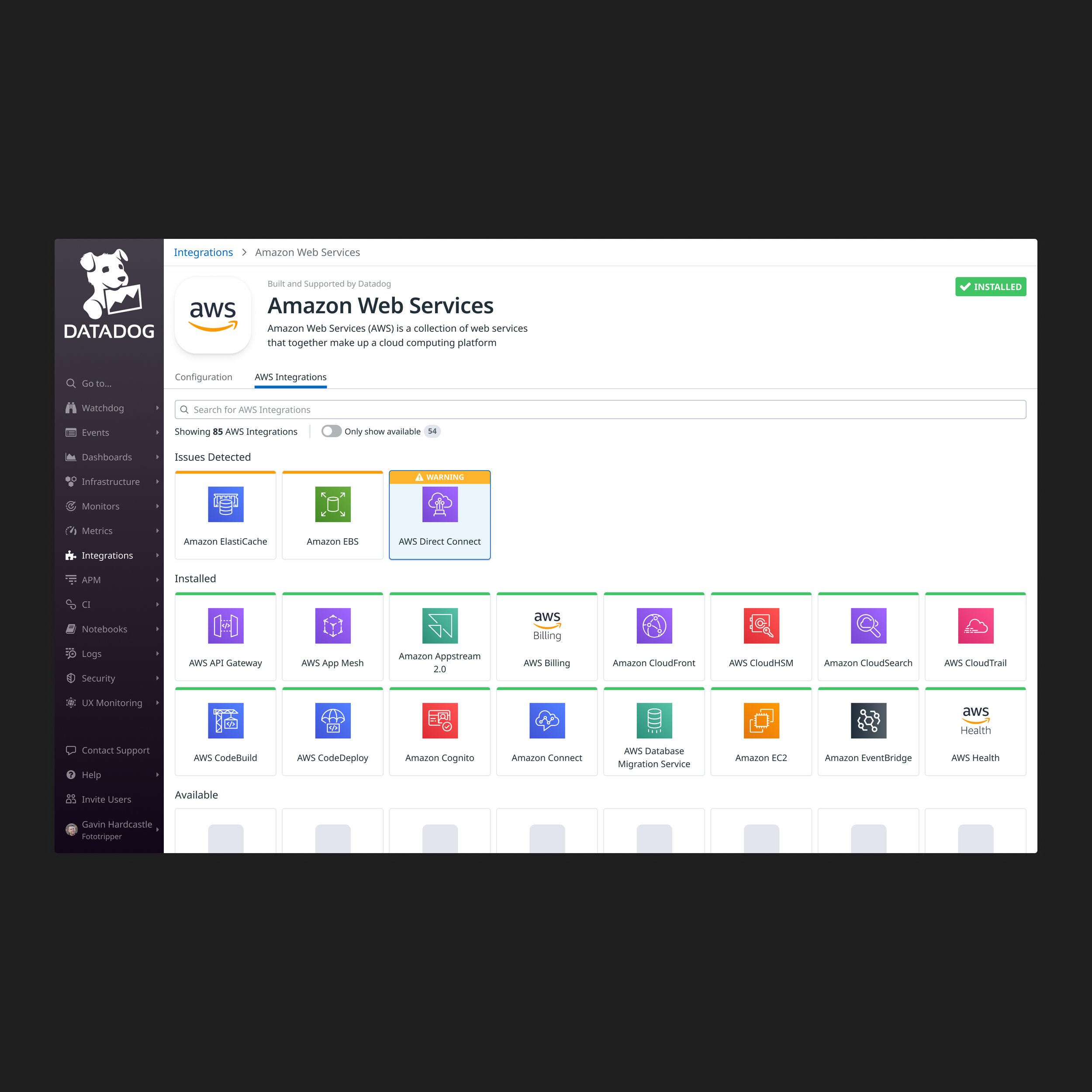CASE STUDY
AWS Integration
Image of user flows
We want Datadog’s interaction with a customer’s AWS environment to be simple, clear and transparent.
With over 100,000 active AWS Accounts, it was crucial that we redesign the AWS Integration to improve all aspects of the user experience. This is because a centralized, single point of entry for the AWS experience helps lower adoption friction and makes it easier to manage the Datadog products that run on data in customer’s AWS environments.
We identified the following core pain points:
Difficulty in creating and configuring accounts, especially accounts with high cardinality
Poor visibility into what data is being collected for individual accounts
Inability to scale requested functionality and features due to outdated design patterns and technical debt
Our research helped us understand just how poor the user experience was. We conducted user interviews with our external customer, sifted through customer success tickets as well as conducted a complete product teardown to outline every possible point of friction.
One of the interesting things we found was that a pivotal part of adding a new account was throwing an error that was costing the company $8 million annually.
Our customer were the biggest source of inspiration because they told us what improvements would help them, and we listened.
We created the following goals in order to be successful with our improvements:
Solve technical debt to unblock us from improving existing and adding features
Allow users to add new accounts and manage existing ones with less friction
Improve data collection settings with greater transparency and control
Reduce the risk of disrupting customer behavior during launch
After validating the need to redesign the AWS Integration, our Product and Design OKRs were approved for us to begin the project. Improving an integration that was 10+ years old is not an easy task and required a high degree of collaboration across the following teams: CEO, Product, Design, Frontend Engineering, Backend Engineering, Documentation, Marketing, and Customer Success.
During the discovery phase, we focused on a few things:
Understand our users to create user stories based on goals they are trying to accomplish with the integration
Create user flows to better understand how users might navigate through the integration and features
Explore and reorganized the information architecture that allows for flexibility and scalability of features
Research what new AWS features and technology we could utilize to improve data flow, connectivity and UX
Explore and outline technical debt to understand current limitations and how to overcome them
During the design phase, we moved into wireframing, high fidelity mockups utilizing our Style Guide, and create prototypes to test internally and externally. We iterated on our designs a lot as we tested throughout the entire project. Feedback was crucial for us to ship the redesign with confidence.
We identified an exhaustive list of solutions that would greatly improve the experience and have the highest impact. Below are a few that were most important:
Address technical debt by:
Rebuilding the Integration on the new SPA framework
Improve the backend and frontend pipelines to handle data flow
Utilize CloudFormation for adding new accounts to reduce friction and time
Introduce AWS Organization Master Accounts
Add search/filter functionality and improve loading of accounts with high cardinality
Include greater parity of API configuration controls (i.e. resource filtering, region metric filtering)
Provide greater control around customer metric collection for CloudWatch
Give better visibility into data collection for accounts
Make error feedback more intuitive
Add ability to make bulk changes across many AWS Accounts
Create roll out strategy and documentation for launch
During the development phase, many conversations were had around technical limitations and how to conquer them to help support and drive our design initiatives. Working with engineering was imperative for a timely and smooth delivery. I also created guidelines for our designs to help our frontend engineers more quickly build the Integration. Before shipping, I lead a few rounds of QA and bug bashes with product and design.
The outcome was stellar! In the end, our customers were extremely pleased because we accomplished our goals and made their lives much easier. Users are able to drastically reduce the time it took to add new AWS Accounts, able to configure and manage 1000s of AWS Accounts with greater control, while being able to configure and filter more data and resources than before.
The impact internally has set the team up for success because we were able to solve technical debt and utilize new design patterns (i.e. Full Page) that can be carried over to every other integration (i.e. Google Cloud Platform).
Image of user stories
Image of information architecture









